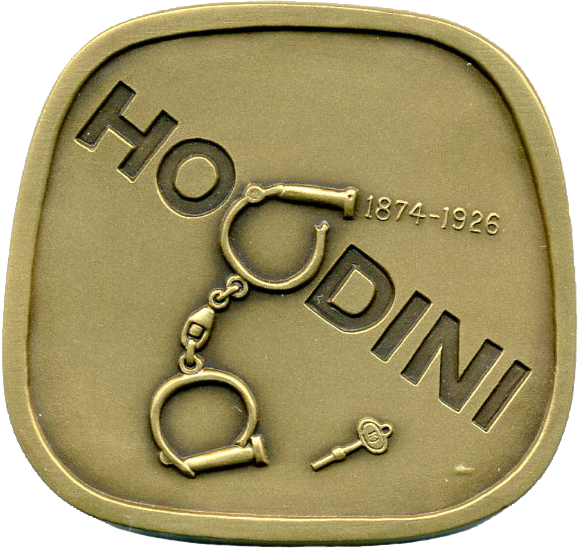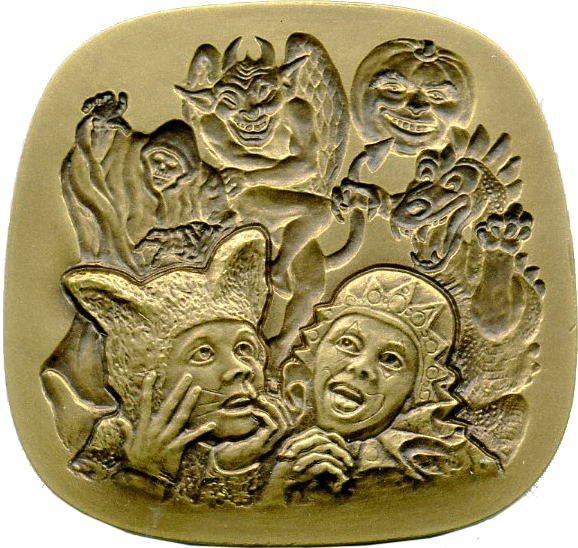 |  |
Houdini medal, upper half of 2-parts, designed by Hal Reed. Struck by Medalcraft Mint in 1996 in quantities of 225 bronze
and 85 pure silver; plus 7 cast in 10kt gold. Obverse: Portrait, Houdini (signature), HR monogram. Reverse: Children in
scary Halloween scene. Edge: MAGNES MUSEUM. Note that the struck medals fit precisely together, while the cast gold
medal is a single piece with portrait obverse and HOUDINI reverse. In 2001, additional medals were produced as follows:
8 bronze (edge: MAGNES), 9 bronze (edge: JEWISH-AMERICAN HALL OF FAME), 36 bronze (edge: 75TH ANNIVERSARY
1926-2001); 5 pure silver (edge: MAGNES), 6 pure silver (edge: JEWISH-AMERICAN HALL OF FAME), 14 pure silver
(edge: 75TH ANNIVERSARY 1926-2001); 3 10kt gold (edge: MAGNES), 4 10kt gold (edge: JEWISH-AMERICAN HALL
OF FAME), 2 10kt gold (edge: 75TH ANNIVERSARY 1926-2001). 49 x 47 mm.
 |  |
Houdini medal, lower half of 2-parts, with “HOUDINI” side designed by Mel Wacks,
and reverse designed by Hal Reed.
Houdini was born Ehrich Weiss on March 24, 1874 in Budapest, Hungary. His family emigrated to the United States while he was an infant, and his father became the first rabbi in Appleton, Wisconsin. They later moved to Milwaukee, and eventually settled in New York. Young Ehrich’s life was transformed after he learned his first trick (the vanishing quarter). At the age of 17, he changed his name to Harry Houdini and began performing in medicine shows, circuses, theaters, etc.
When 100,000 people watched “The King of Handcuffs” wriggle free while hanging from a building in 1916, a newspaper reported that this was “the biggest crowd ever assembled in Washington at one place except for the inauguration of the President.” One of Houdini’s most spectacular illusions was the “Vanishing Elephant,” in which the pachyderm lumbered on to the stage and walked straight into a large cabinet. Almost simultaneously the cabinet’s walls would be pulled back and the elephant had disappeared. Houdini said “Even the elephant does not know how it is done.”
Four years after the Wright Brothers flew the first practical airplane, Houdini bought a French Voisin biplane and made his first flight. Just five months later, on March 16, 1910, he became the first person to make a controlled, powered flight of an airplane in Australia.
Houdini was also a motion picture star, making his first appearance in 1918 in a serial The Mastery Mystery. Soon he set up the Houdini Picture Corporation where he wrote and starred in The Man from Beyond and Haldane of the Secret Service. On October 31, 1975 Houdini’s pioneering accomplishments earned him a star on the Hollywood Walk of Fame.
Houdini was in his dressing room at the Princess Theater in Montreal on October 22, 1926 when a student asked if it was true that Houdini could sustain punches to his midsection without injury. The visitor struck him immediately, not realizing that Houdini had to brace himself. Even though Houdini had stomach pain, he boarded the train for his next appearance in Detroit. Collapsing after the final curtain, Houdini was taken to the hospital, where his ruptured appendix was removed. But it was too late, and he passed away on October 31 — Halloween. At his funeral, Rabbi Bernard Drachman called Houdini “one of the truly great men of the age.”